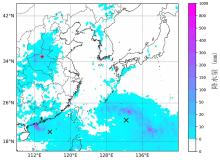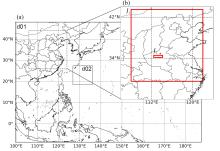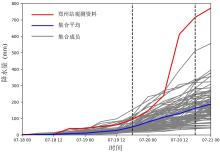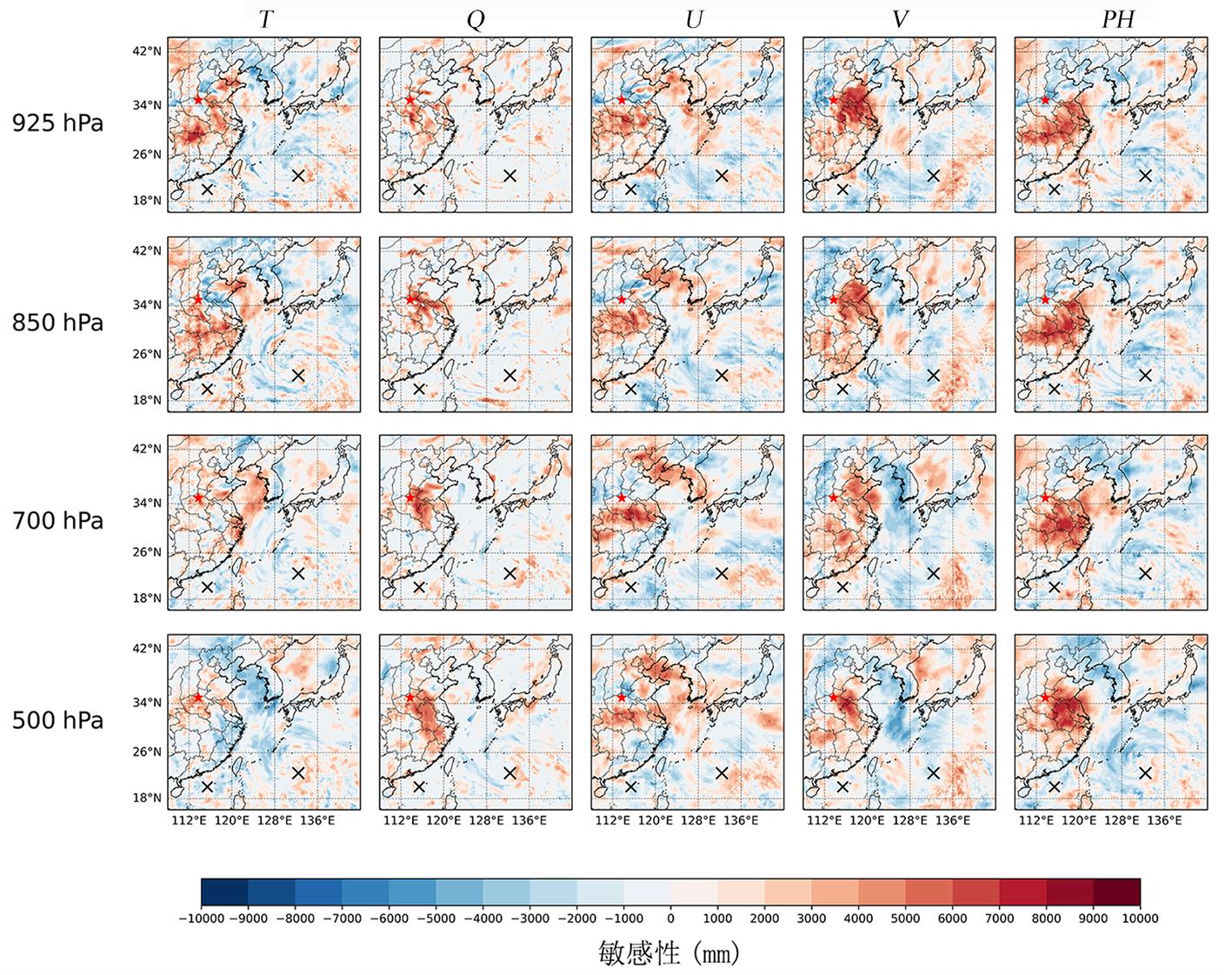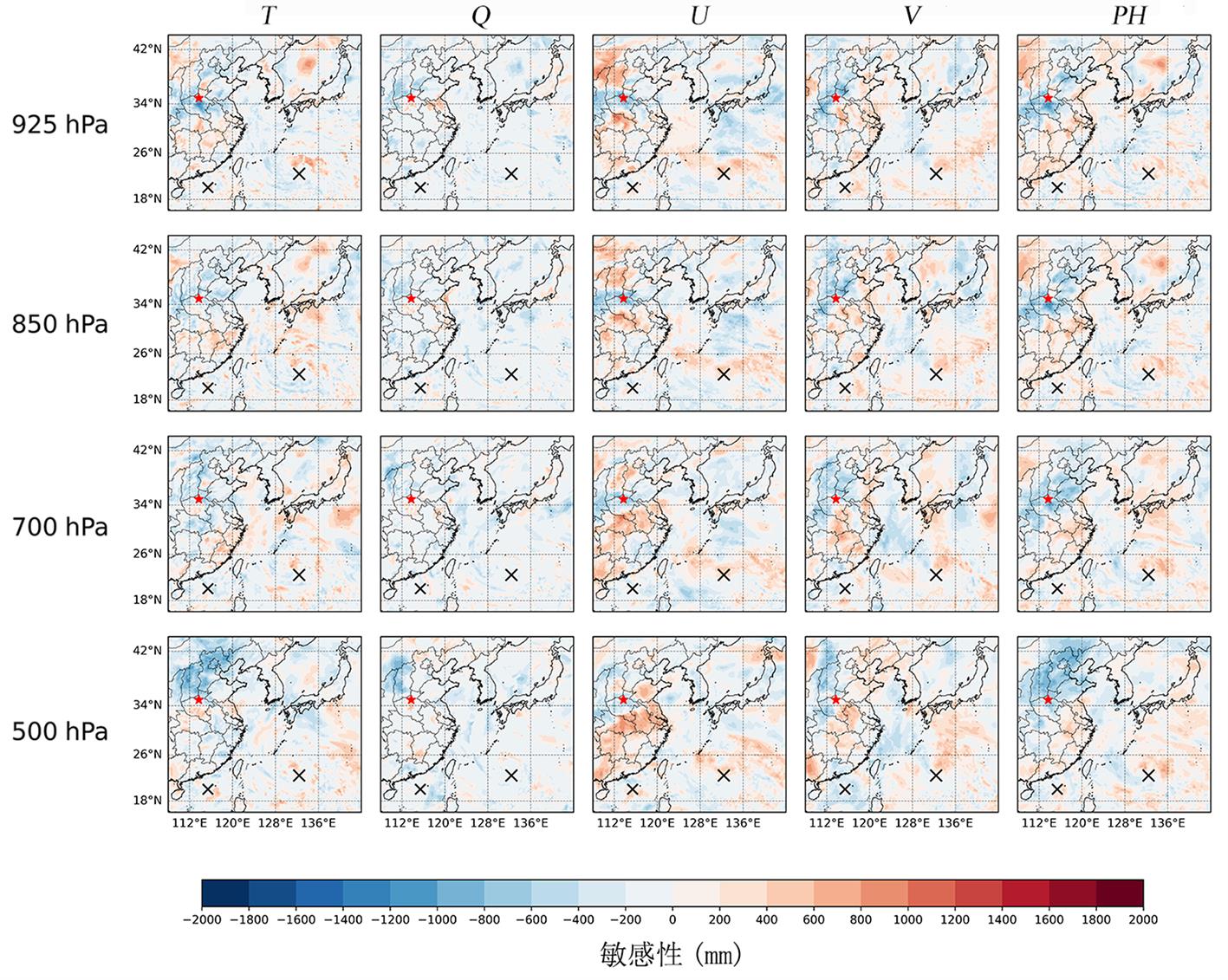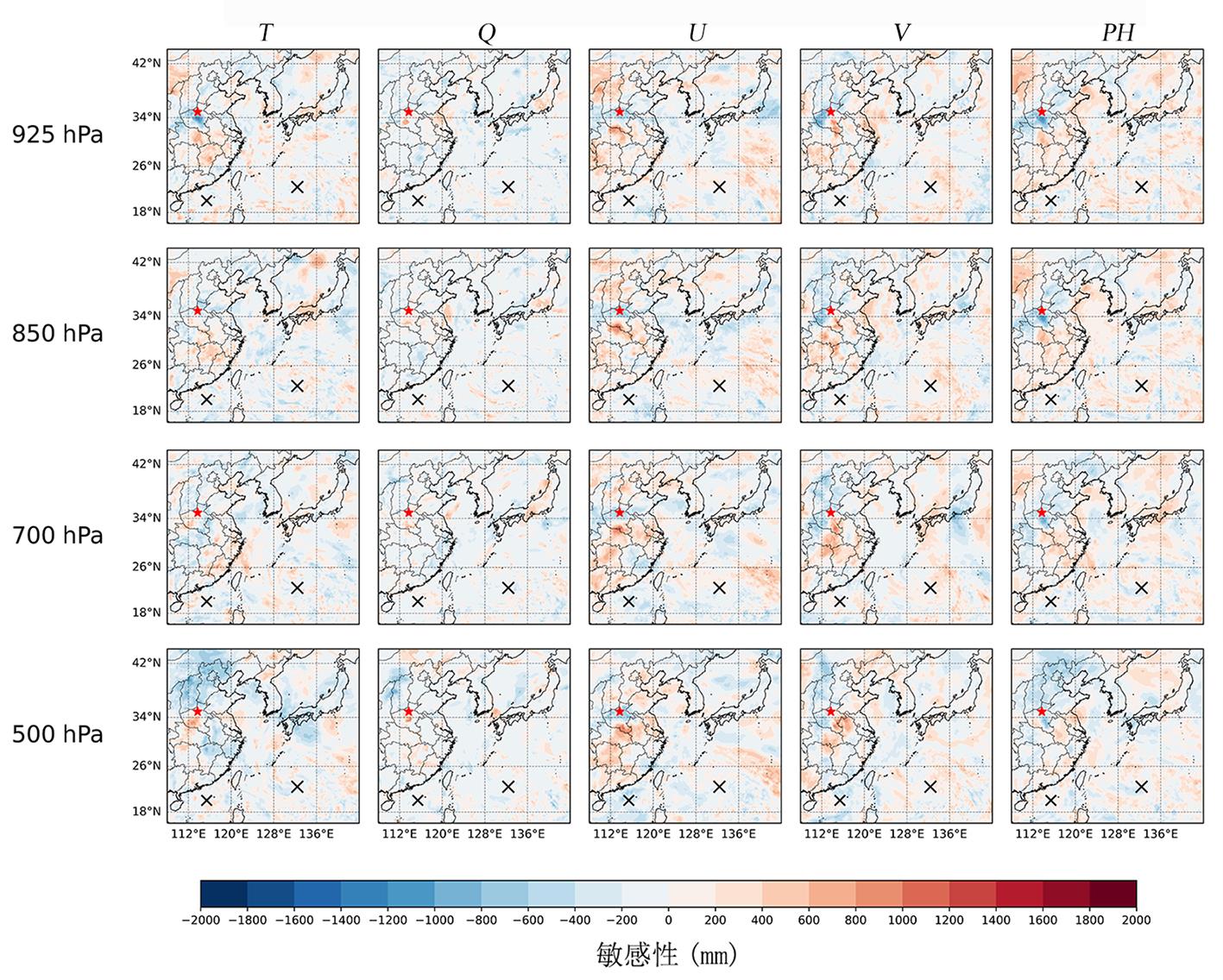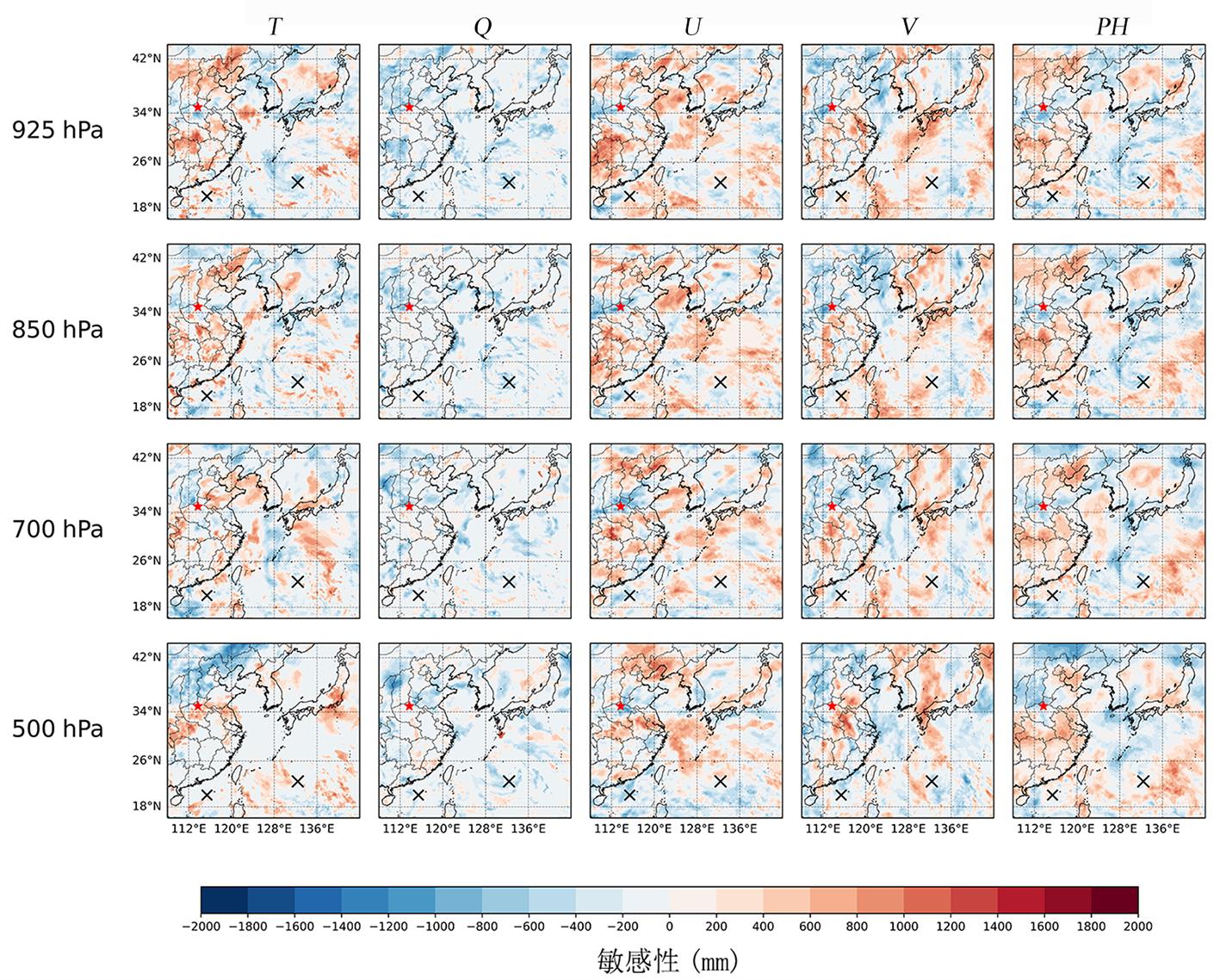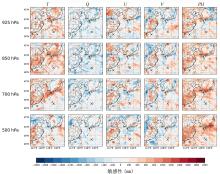南京大学学报(自然科学版) ›› 2024, Vol. 60 ›› Issue (2): 181–193.doi: 10.13232/j.cnki.jnju.2024.02.001
• • 下一篇
“21.7”河南暴雨的集合敏感性分析
- 1.中尺度灾害性天气教育部重点实验室,南京大学大气科学学院,南京,210093
2.地球系统数值预报中心,中国气象局,北京,100081
Ensemble sensitivity analysis for the "21.7" Henan extreme rainstorm
Zhiyu Zhao1, Jin Zhang2, Lili Lei1( ), Yi Zhang1
), Yi Zhang1
- 1.Key Laboratory of Mesoscale Severe Weather,Ministry of Education,and School of Atmospheric Sciences,Nanjing University,Nanjing,210093,China
2.Center for Earth System Modeling and Predictino,China Meteorological Administration,Beijing,100081,China
摘要:
河南郑州“21.7”特大暴雨是中国近年来发生的一场严重气象灾害,对此暴雨事件的数值预报模式表现出较大的不确定性,对暴雨落区和降水强度的预测均存在偏差.目前,“21.7”河南暴雨的形成机理已经得到广泛研究,但针对其集合敏感性分析的研究却十分有限.集合敏感性分析是一种利用集合预报来估计模式预报对初始场敏感性的方法,可诊断极端天气过程的影响因子、对数值模式集合预报不确定性进行分析等.因此,针对“21.7”河南暴雨个例,利用WRF?ARW模式,结合集合初始条件与多物理过程以及物理过程扰动等方法,构建不同的区域模式集合预报.利用集合敏感性分析方法开展“21.7”河南暴雨的可预报性和影响该暴雨的因子分析.结果表明,“21.7”河南暴雨对初始条件的温度场、湿度场、风场和位势高度场扰动具有敏感性,增强郑州地区的气旋性环流、改变郑州上空的气温、降低郑州地区的气压、增强台风“烟花”的强度可以使此次暴雨的降水强度增强.本研究能够增进对“21.7”河南暴雨成因的理解,并改进集合预报.
中图分类号:
- P456.7
| 1 | 栗晗,王新敏,朱枫. “21.7”河南极端暴雨多模式预报性能综合评估. 大气科学学报,2022,45(4):573-590. |
| Li H, Wang X M, Zhu F. Comprehensive evaluations of multi?model forecast performance of “21.7” Henan extreme rainstorm. Transactions of Atmospheric Sciences,2022,45(4):573-590. | |
| 2 | Errico R M, Raeder K D, Fillion L. Examination of the sensitivity of forecast precipitation rates to possible perturbations of initial conditions. Tellus A:Dynamic Meteorology and Oceanography,2003,55(1):88-105. |
| 3 | Hakim G J, Torn R D. Ensemble synoptic analysis. Meteorological Monographs,2008,33(55):147-162. |
| 4 | Chu K K, Tan Z M. Mesoscale moist adjoint sensitivity study of a Mei?Yu heavy rainfall event. Advances in Atmospheric Sciences,2010,27(6):1415-1424. |
| 5 | Errico R M. What is an adjoint model? Bulletin of the American Meteorological Society,1997,78(11):2577-2592. |
| 6 | Ancell B, Hakim G J. Comparing adjoint? and ensemble?sensitivity analysis with applications to observation targeting. Monthly Weather Review,2007,135(12):4117-4134. |
| 7 | Ren S J, Lei L L, Tan Z M,et al. Multivariate ensemble sensitivity analysis for super typhoon Haiyan (2013). Monthly Weather Review,2019,147(9):3467-3480. |
| 8 | Torn R D, Hakim G J. Ensemble?based sensitivity analysis. Monthly Weather Review,2008,136(2):663-677. |
| 9 | Chang E K M, Zheng M H, Raeder K. Medium?range ensemble sensitivity analysis of two extreme Pacific extratropical cyclones. Monthly Weather Review,2013,141(1):211-231. |
| 10 | 姚秀萍,李若莹. 河南“21.7”极端暴雨的研究进展. 气象学报,2023,81(6):853-865. |
| Yao X P, Li R Y. Progress in research of the July 2021 extreme precipitation event in Henan province,China. Acta Meteorologica Sinica,2023,81(6):853-865. | |
| 11 | National Centers for Environmental Prediction,National Weather Service,NOAA,et al. NCEP FNL operational model global tropospheric analyses,April 1997 through June 2007. Research Data Archive at the National Center,1997. DOI:https://rda.ucar.edu/datasets/ds083.2/ . |
| 12 | Skamarock W C, Klemp J B, Dudhia J,et al. A description of the advanced research WRF model version 4.1. Technical Report. No. NCAR/TN?556+STR,Boulder:National Center for Atmospheric Research,2019:145. |
| 13 | Gaspari G, Cohn S E. Construction of correlation functions in two and three dimensions. Quarterly Journal of the Royal Meteorological Society,1999,125(554):723-757. |
| 14 | Hacker J P, Lei L L. Multivariate ensemble sensitivity with localization. Monthly Weather Review,2015,143(6):2013-2027. |
| 15 | 崔晓鹏,杨玉婷. “21.7”河南暴雨水汽源地追踪和定量贡献分析. 大气科学,2022,46(6):1543-1556. |
| Cui X P, Yang Y T. Tracking and quantitative contribution analyses of moisture sources of rainstorm in Henan Province in July 2021. Chinese Journal of Atmospheric Sciences,2022,46(6):1543-1556. | |
| 16 | Hong S Y, Lim J O J. The WRF single?moment 6?class microphysics scheme (WSM6). Journal of the Korean Meteorological Society,2006,42(2):129-151. |
| 17 | Thompson G, Rasmussen R M, Manning K. Explicit forecasts of winter precipitation using an improved bulk microphysics scheme. Part I:Description and sensitivity analysis. Monthly Weather Review,2004,132(2):519-542. |
| 18 | Zheng Y, Alapaty K, Herwehe J A,et al. Improving high?resolution weather forecasts using the Weather Research and Forecasting (WRF) Model with an updated Kain–Fritsch scheme. Monthly Weather Review,2016,144(3):833-860. |
| 19 | Hong S Y, Noh Y, Dudhia J. A new vertical diffusion package with an explicit treatment of entrainment processes. Monthly Weather Review,2006,134(9):2318-2341. |
| 20 | Han J, Witek M L, Teixeira J,et al. Implementation in the NCEP GFS of a hybrid eddy?diffusivity mass?flux (EDMF) boundary layer parameterization with dissipative heating and modified stable boundary layer mixing. Weather and Forecasting,2016,31(1):341-352. |
| 21 | Detering H W, Etling D. Application of the E?ε turbulence model to the atmospheric boundary layer. Boundary?Layer Meteorology,1985,33(2):113-133. |
| 22 | Olson J B, Smirnova T, Kenyon J S,et al. A description of the MYNN surface?layer scheme. NOAA Technical Memorandum OAR GSL?67,Boulder:National Oceanic and Atmospheric Administration,2021. |
| 23 | Jiménez P A, Dudhia J, González?Rouco J F,et al. A revised scheme for the WRF surface layer formulation. Monthly Weather Review,2012,140(3):898-918. |
| 24 | Mlawer E J, Taubman S J, Brown P D,et al. Radiative transfer for inhomogeneous atmospheres:RRTM,a validated correlated?K model for the longwave. Journal of Geophysical Research:Atmospheres,1997,102(D14):16663-16682. |
| 25 | Ek M B, Mitchell K E, Lin Y,et al. Implementation of Noah land surface model advances in the National Centers for Environmental Prediction operational mesoscale Eta model. Journal of Geophysical Research:Atmospheres,2003,108(D22):8851. |
| 26 | Palmer T N, Buizza R, Doblas?Reyes F,et al. Stochastic parametrization and model uncertainty. Shinfield Park:European Centre for Medium?Range Weather Forecasts,2009. |
| 27 | Shutts G. A kinetic energy backscatter algorithm for use in ensemble prediction systems. Quarterly Journal of the Royal Meteorological Society,2005,131(612):3079-3102. |
| 28 | Lei L L, Ge Y J X, Tan Z M,et al. Evaluation of a regional ensemble data assimilation system for typhoon prediction. Advances in Atmospheric Sciences,2022,39(11):1816-1832. |
| 29 | Whitaker J S, Hamill T M, Wei X,et al. Ensemble data assimilation with the NCEP global forecast system. Monthly Weather Review,2008,136(2):463-482. |
| 30 | Torn R D, Hakim G J, Snyder C. Boundary conditions for limited?area ensemble Kalman filters. Monthly Weather Review,2006,134(9):2490-2502. |
| [1] | 张心怡, 张熠, 刘昊炎, 王其伟, 王迪. 模拟启动时间和双台风对“21.7”河南极端暴雨事件的影响研究[J]. 南京大学学报(自然科学版), 2024, 60(2): 194-208. |
| [2] | 廉丹华, 袁慧玲, 王婧羽, 陈法敬. 河南“21.7”特大暴雨的区域集合预报检验和预报偏差分析[J]. 南京大学学报(自然科学版), 2024, 60(2): 287-300. |
| [3] | 李嘉鹏,汤剑平** . WRF模式对中国东南地区的多参数化短期集合预报试验*[J]. 南京大学学报(自然科学版), 2012, 48(6): 677-688. |
|
||



